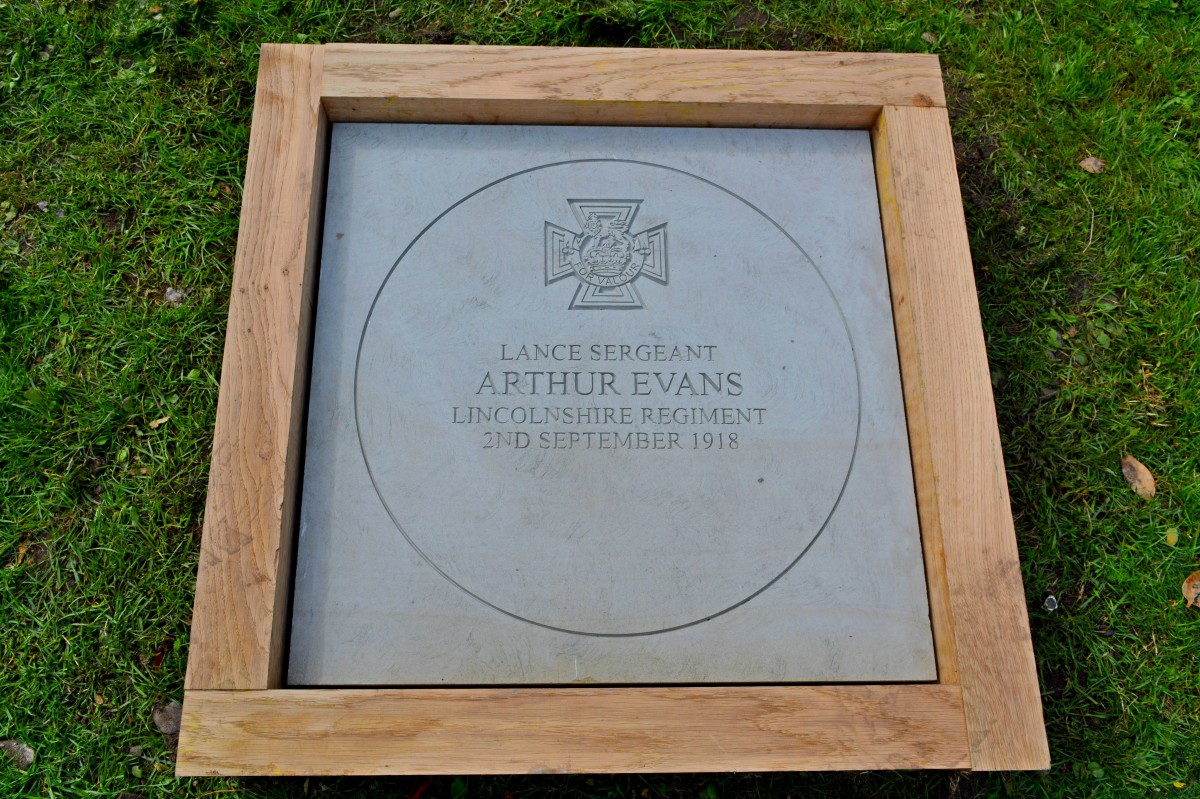A Memorial stone to Seaforth born Arthur Evans was unveiled earlier in a small ceremony in Bowersdale Park, Seaforth.
Arthur Walter Evans (1891-1936) was born on 8th April 1891 in Sefton, Liverpool. On leaving school, Evans went to work in an office. He left the office to join the Royal Navy as a stoker, but was discharged (as an invalid) due to an accident. He joined the Merchant Navy, shipped out to America, jumped ship, and supposedly was a supervisor of a crew working on the Panama Canal. He explored South America with a couple of friends, but caught malaria and then made his way to Cuba and the United States. Evans earned passage back to England on a four-mast sailing ship that took a year for the journey, going by way of Australia.
For some unknown reason, about this time he changed his name to Walter Simpson and using this name, in May 1914, he joined the 1st King’s Liverpool Regiment. His Medal Record card shows that Arthur Evans served overseas first as a Lance Corporal with the King’s Liverpool Regiment (L/Cpl 11930), then as a Sergeant with the Lincolnshire Regiment (Sjt 41788). Finally, he was a Sergeant with 243rd Training Reserve Battalion (20353). He first arrived in France on 12th August 1914.
Simpson (Evans) saw service in the Retreat from Mons and in the First Battle of Ypres, then either transferred to or possibly deserted from the 1st Kings right before they left for the Middle East, as his next unit was the 6th Battalion of the Lincolnshire Regiment.
On 2nd September 1918 south west of Etaing, France, a patrol reconnoitring on the west bank of a river sighted an enemy machine-gun on the east bank. The river being very deep at that point, Lance-Sergeant Evans volunteered to swim across and having done so crawled up behind the machine-gun post, where he shot the sentry and another man and made four more surrender. After a crossing had been found and one officer and one man joined him, machine-gun and rifle fire was opened on them. The officer was wounded and Sergeant Evans covered his withdrawal under very heavy fire.
Following his citation being published with the name Walter Simpson (later corrected), he was presented with his VC on December 3rd 1918 at Valenciennes, France by King George V. There are conflicting accounts of his life post-war, one version having him emigrating to Australia to escape the long arm of the law. He did enlist in the Australian Army and served with the Tank Corps for two and a half years, but was invalided out due to the after-effects of being gassed in WWI.
Arthur passed away in the Repatriation Hospital, Sydney on 1st November 1936 at the age of just 45, and he was cremated. In November 1936 the Australian Government, as a tribute of respect to Evans’ fighting record, arranged for his ashes to be borne back to his native land. They were placed in the personal charge of Corporal Arthur Sullivan VC because of his close friendship with the dead man. Sullivan’s duty was to hand the ashes to his friend’s relatives for burial in the grave of a soldier brother in England. On disembarkment at Tilbury, Corporal Sullivan went to St. Annes-on-Sea and placed the urn in the headquarters of the St. Annes-on-Sea branch of the British Legion, where it lay until handed over to Evans’ surviving brother. The ashes of Arthur Evans, carried by two members of the British Legion and followed by his four relatives, were interred at Lytham St. Annes Park Cemetery with the remains of his stepbrother. His sad duty fulfilled, Sullivan returned to London, whilst waiting for passage back to Australia, tragically; on 9th April 1937, Sullivan was involved in an accident in which he fell while walking to his quarters. He was taken to hospital but died soon after from head injuries sustained in the accident. Sullivan was accorded a full military funeral in London. His ashes were returned to Sydney.
For photo’s and video see my links below:-
Photo’s – https://www.flickr.com/photos/napoleon666uk/albums/72157695243950630
Video – https://youtu.be/K-PHdFdqZio



